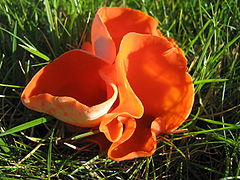Pyronemataceae
| Pyronemataceae | |
|---|---|
 | |
Aleuria aurantia, member of the Pyronemataceae | |
Scientific classification | |
| Kingdom: | Fungi |
| Division: | Ascomycota |
| Class: | Pezizomycetes |
| Order: | Pezizales |
| Family: | Pyronemataceae Corda |
Type genus | |
Pyronema Carus | |
The Pyronemataceae are a family of fungi in the order Pezizales. It is the largest family of the Pezizales, encompassing 75 genera[1] and approximately 500 species.[2] Recent phylogenetic analyses does not support the prior classifications of this family, and suggest that the family is not monophyletic as it is currently circumscribed.[3]
Morphology
Members of the family are diverse in ascomatal or cleistothecial form. Individual taxa may be sessile (without a stipe) to shortly stipitate, cupulate (cup-shaped), discoid (disc-shaped), pulvinate (cushion-shaped), or with turbinate (turban-shaped) epigeous apothecia. Also, taxa may be sub-hypogeous to hypogeous with closed, folded, or solid ascomata. Apothecia may range in size from less than 1 mm up to 12 cm diam, and may be brightly colored due to carotenoid pigments. Genera of the Pyronemataceae lack unifying macroscopic or microscopic characteristics; this lack of uniting characters has led various authors to propose a variety of classification schemes.[4][5][6]
Genera
This list of genera in the family Pyronemataceae is based on the Outline of Ascomycota (dated Dec 31st, 2007),[7] and articles published since then:
Acervus,
Aleuria,
Aleurina,
Anthracobia,
Aparaphysaria,
Arpinia,
Ascocalathium,
Ascosparassis,
Boubovia,
Byssonectria,
Boudierella,
Chaetothiersia,[8]Chalazion,
Cheilymenia,
Cleistothelebolus,
Dictyocoprotus,
Eoaleurina,
Galeoscypha,
Genabea,
Genea,
Geneosperma,
Geopora,
Geopyxis,
Gilkeya,
Hiemsia,
Hoffmannoscypha,[9]Humaria,
Hydnocystis,
Hypotarzetta,
Jafnea,
Kotlabaea,
Lamprospora,
Lasiobolidium,
Lathraeodiscus,
Lazuardia,
Leucoscypha,
Luciotrichus,
Melastiza,
Micronematobotrys,[10]Miladina,
Moravecia,
Mycogalopsis,
Nannfeldtiella,
Neottiella,
Nothojafnea,
Octospora,
Octosporella,
Orbicula (placement uncertain),
Otidea (synonymous with Otideopsis and Flavoscypha),
Oviascoma,
Parascutellinia,
Paratrichophaea,
Paurocotylis,
Petchiomyces,
Phaeangium,
Pseudaleuria,
Pseudombrophila,
Psilopezia,
Pulvinula,
Pyronema,
Pyropyxis,
Ramsbottomia,
Rhizoblepharia,
Rhodoscypha,
Rhodotarzetta,
Scutellinia,
Smardaea,
Sowerbyella,
Sphaerosoma,
Sphaerosporella,
Spooneromyces,
Stephensia,
Tarzetta,
Tricharina,
Trichophaea,
Trichophaeopsis,
Warcupia,
Wenyingia,
Wilcoxina
References
^ Eriksson OE. Outline of Ascomycota. 2006 Myconet 12:1–82.
^ Kirk PM, Cannon PF, David J, Stalpers JA. (Eds.) Ainsworth & Bisby's Dictionary of the Fungi (9th edn.). CAB International: Wallingford, UK (2001).
^ Perry BA, Hansen K, Pfister DH (2007). "A phylogenetic overview of the family Pyronemataceae (Ascomycota, Pezizales)". Mycological Research. 111 (5): 549–571. doi:10.1016/j.mycres.2007.03.014. PMID 17572335..mw-parser-output cite.citation{font-style:inherit}.mw-parser-output q{quotes:"""""""'""'"}.mw-parser-output code.cs1-code{color:inherit;background:inherit;border:inherit;padding:inherit}.mw-parser-output .cs1-lock-free a{background:url("//upload.wikimedia.org/wikipedia/commons/thumb/6/65/Lock-green.svg/9px-Lock-green.svg.png")no-repeat;background-position:right .1em center}.mw-parser-output .cs1-lock-limited a,.mw-parser-output .cs1-lock-registration a{background:url("//upload.wikimedia.org/wikipedia/commons/thumb/d/d6/Lock-gray-alt-2.svg/9px-Lock-gray-alt-2.svg.png")no-repeat;background-position:right .1em center}.mw-parser-output .cs1-lock-subscription a{background:url("//upload.wikimedia.org/wikipedia/commons/thumb/a/aa/Lock-red-alt-2.svg/9px-Lock-red-alt-2.svg.png")no-repeat;background-position:right .1em center}.mw-parser-output .cs1-subscription,.mw-parser-output .cs1-registration{color:#555}.mw-parser-output .cs1-subscription span,.mw-parser-output .cs1-registration span{border-bottom:1px dotted;cursor:help}.mw-parser-output .cs1-hidden-error{display:none;font-size:100%}.mw-parser-output .cs1-visible-error{font-size:100%}.mw-parser-output .cs1-subscription,.mw-parser-output .cs1-registration,.mw-parser-output .cs1-format{font-size:95%}.mw-parser-output .cs1-kern-left,.mw-parser-output .cs1-kern-wl-left{padding-left:0.2em}.mw-parser-output .cs1-kern-right,.mw-parser-output .cs1-kern-wl-right{padding-right:0.2em}
^ Kimbrough JW. Arguments towards restricting the limits of the Pyronemataceae (Ascomycetes, Pezizales). Memoirs of the New York Botanic Garden. 1989 49:326–335.
^ Eckblad F-E. The genera of operculate Discomycetes. A re-evaluation of their taxonomy, phylogeny and nomenclature. Norwegian Journal of Botany. 1968 15:1–191.
^ Korf RP. Synoptic key to the genera of Pezizales. Mycologia. 1972 64:937–94.
^ "Myconet". Retrieved 2009-01-16.
^ Perry BA. (2008). Chaetothiersia vernalis, a new genus and species of Pyronemataceae (Ascomycota, Pezizales) from California. Fungal Diversity 28: 65–72.
^ Stielow B, Hensel G, Strobelt D, Makonde HM, Rohde M, Dijksterhuis J, Klenk HP, Göker M (2013). "Hoffmannoscypha, a novel genus of brightly coloured, cupulate Pyronemataceae closely related to Tricharina and Geopora". Mycological Progress. 12 (4): 675–86. doi:10.1007/s11557-012-0875-1.
^ Sun X, Guo LD (2010). "Micronematobotrys, a new genus and its phylogenetic placement based on rDNA sequence analyses" (PDF). Mycological Progress. Springer. 9 (4): 567–574. doi:10.1007/s11557-010-0664-7. Retrieved 29 December 2010.
